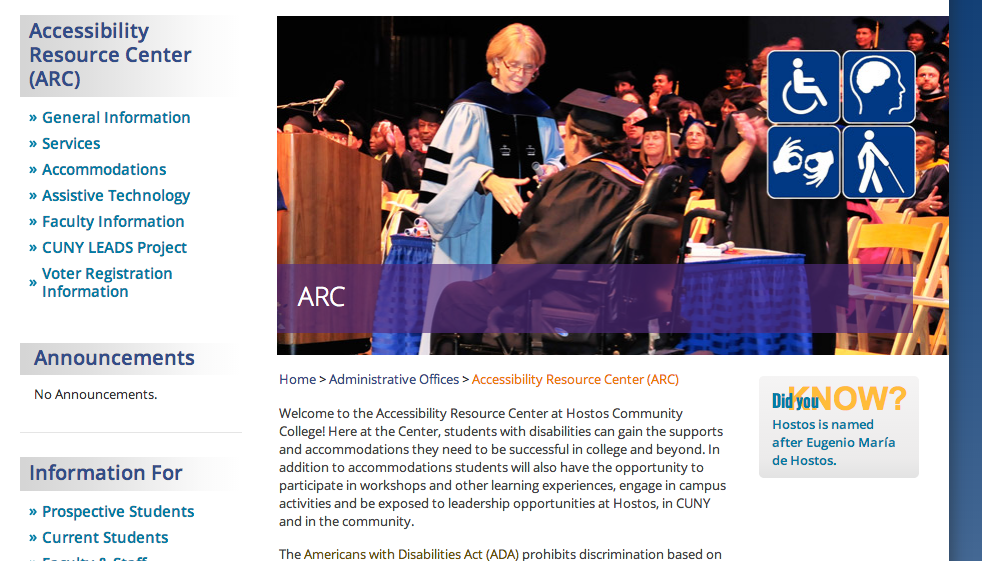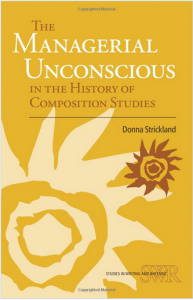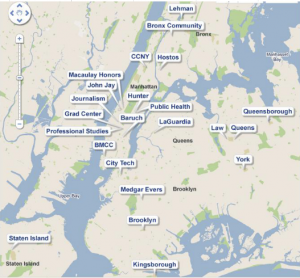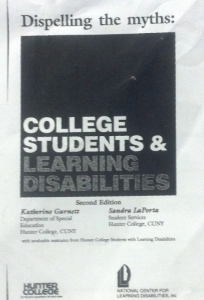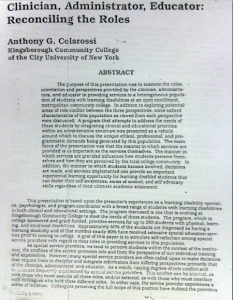I presented this talk on July 17, 2015 at the annual conference of Council of Writing Program Administrators in Boise, Idaho. I would be grateful for feedback, either as comments to this post, or via email at [email protected]
In the last few years, WPA studies has begun to look seriously at the challenges of improving access to students with disabilities. This is in no small part because the growing movement Disability Rhetoric movement has produced innovative scholarship that show how disability issues are central to our work as writing instructors and intellectual-bureaucrats.
For instance, scholars like Patricia Dunn, Melanie Yergeau, and Margaret Price have shown how writing curriculum and classroom practices can be built to accommodate the full participation of all students. Or how, if unchanged, they exclude many kinds of students.
Others have taken a broader institutional look outside the writing classroom. Jay Dolmage, for instance, has critiqued the current prevailing model of disability access in North American higher education (“From Retrofit to Universal Design,” 2012). Under Section 504 of the Rehabilitation Act of 1973, all federally funded institutions of higher education are required to provide so-called “reasonable accommodations” to ensure the full access and participation of persons with disabilities.These accommodations, which are traditionally administered by a disability services director, are meant to ensure disabled students do not face unlawful barriers to their success, for instance not being able to access library resources, get to and from classes, or take exams in an appropriate environment.
The problem is that the accommodation model, Dolmage argues, works as a retrofit, offering only the minimum required alteration to what is fundamentally an exclusionary institution. The changes disability directors are authorized to make are one-offs, applied only to one student at a time. Seen in this way, it is we as writing instructors and program administrators who have the power to make the most change in the disability landscape, not by making one-off changes, but by fundamentally re-designing our programs to better allow full, diverse participation.
I want to talk briefly about my dissertation research and how I’m hoping it will contribute to the work of Disability Rhetoric. With the exception of Brenda Brueggemann’s work on the history of Gauladette University (1999), much of our theory has taken the present as its focal point. Our field’s history of disabled students at mainstream colleges is fragmentary at best.
One significant reason we know so little about the history of disability in higher education relates to Mark’s conception of institutional amnesia. Most of the history of disability access work on campuses has passed unrecorded in our institutional archives. In part this is a willful omission, because, at least in recent times, disability labor is done confidentially. However, it’s also because most of the labor itself was hum drum: one part bureaucratic, finding funding to pay students to read for their blind peers; one part personal, counseling students how to deal with a bigoted instructor. Except in rare cases, almost no paper trail exists in official institutional archives.
My research focuses on the history of disability-specific programming in the City University of New York system. CUNY offers a compelling object of study for a number of reasons. First it has one of the longest histories. In 1946, it developed one of the first programs in the nation specifically aimed to integrate disabled students in a mainstream college setting. This program, begun to provide college access for wounded veterans returning from World War II, was at the cutting edge among the handful of other such programs around the nation. This program predates the earliest disability-access laws by nearly thirty years, and thus offers a rare snap-shot of the early attitudes about disabled students and their education.
CUNY also affords a wide scope in terms of institutional diversity. Since CUNY is comprised of seventeen teaching campuses, each campus has its own independently operated disability services office. Each is attuned to its individual campus character, whether that be a community, four year, or graduate campus. Each campus has a legacy of specially designed programs. Some of these proliferated and spread around the system, some of which died out within a few years. Each campus keeps its own institutional archives, though, naturally, there is vast inconsistency in terms of what records are kept by each archivist and whether disability issues get a folder. For instance, I have yet to find any materials related to disabled student clubs and organizations, though I know for a fact they’ve existed for at least twenty years.
Oral history provides a key to unlocking much of this history. So far, I have interviewed thirteen current or former disability service providers from across the CUNY system. My informants range from people who began working in the field within the past academic year to those who worked on disability integration in the mid 1960s. One informant, whom I only identified a few weeks ago, was actually a student who graduated through that early program established in the ’40s, who later went on to direct the disability office at his own alma mater.
In addition to informing me about the nature of their work as service providers, these informants also give me important information about the attitudes toward disability and access held of students, faculty, and other branches administration of their home institutions while they worked there.
CUNY’s unique multi-campus structure created a kind of incubation chamber for sharing ideas about disability access. Those of us who know CUNY’s history of basic writing scholarship will be familiar with how the SEEK program Sean just described and the system of basic writing fostered scholars like Kenneth Bruffee, Mina Shaughnessey, Sondra Perl, and many others. These scholars shared their work through informal networks around the CUNY system, learning from one another before spreading their work publicly. CUNY service providers did the same, forming a coalition of administrators in which they could share ideas, developed best practice guidelines, publish scholarship, and organize for public engagement, both at the campus and at the state level.
It is partially because of the close personal connections formed within this coalition, called COSDI, the Coalition on Student Disability Issues, that my research has been possible. COSDI members who are now reaching retirement are eager to get on record the important work that they did over the years. Additionally, many of these individuals kept personal archives of their work, materials not available in any official collection.
One of my aims in this research is to use the programs that were developed to serve disabled students at different historical moments as a lens to better understand these students’ institutional position. I’ll explain what I mean with a few quick snap-shots from my research so far.
As I said, the 1946 program housed City College (then known as the Uptown campus), was initially designed to grant access to wounded veterans. In fact, an influx of wounded vets didn’t materialize, and the program instead oversaw the admissions of a few dozen disabled civilians each year from 1946 to the mid 1960s. In general these students had either sensory impairments or chronic health conditions. The campus was closed to students who use wheelchairs. There was at this time, of course, no popular concept of learning disabilities.
In some ways, this early program resembles modern disability services programs. Students were assessed by college staff and received special help with registration. The students’ instructors received a kind of accommodation letter, just like today.
However, unlike modern disability services, the program was designed to serve people recovering from wounds, and so the entire enterprise was suffused with a highly medicalized view of the students and their educational needs. In order to gain admissions to the college, students were subject to examination by the Health Guidance Board, a group of faculty, administrators, and physicians who, according to the college bulletin, were authorized to determine “whether they could profit from college training (Bulletin 1968/69)” before granting them access.
The Health Guidance Board’s mission went beyond simply assessing students for admissions. According to one institutional document, the Board also worked to “[effect] adjustment to the maximum correction of physical defects” in the students. The most widely publicized aspect of this recuperative mission came from a four semester series of special physical hygiene courses disabled students were required to take. Instructors in these PE courses were briefed on students’ health conditions and charged with designing each student an individualized rehabilitation plan, with biannual reports on their progress made available both to the Health Board and to “all instructors interested in the health of the student.” (I should note that four semesters of PE were required for all students at this time, but only students overseen by the Health Guidance Board were subjected to these special sections.) We can think of this program, described as (quote) “the reconstructive education of the physically handicapped [which is] concerned primarily with the prevention and correction of physical defects” as, perhaps, remedial courses in normative embodiment.
This early program reflects, in many ways, the medical model of disability that dominated before the advent of the disability rights movement in the 1960s and 70s. In this model, disability is thought of as an individual problem, a defect located in the body. As the politics of disability changed, disability programs began to shed some of their medicalized perspective—where disabled students essentially lived as patients of the university—and instead began to align with the social model of disability. Within this model, disability is understood as a problem of social oppression, not a problem of physical defects. This logic argues that disabled people don’t need curing, they need the same level of social access and resources afforded to the able-bodied majority, and laws passed in the mid 1970s asserted that these resources and affordances were, in fact, their right. Programs developed during this period tend to bear the marks of this political alignment, most notably the Distance Education Program for the Homebound, which I can tell you about in Q&A. Obviously, for those of us interested in the history of basic writing, we can hear a lot of resonance in this political shift from seeing disabled students as broken or deficient to seeing them as people disenfranchised by oppressive social systems.
To conclude, I want to turn my attention to another program from CUNY past. This one I know about entirely based on personal interviews and a pile of personal documents generously donated by my informant.
By the early 1980s, CUNY was receiving an influx of a new kind of disabled student. These were students who had come up through the public K12 system under the purview of federal Public Law 94-142, then called the Education for All Handicapped Children Act, which was passed in 1975. This law mandated that whenever possible, disabled students should be taught in mainstream classrooms (“Least Restrictive Environments”). The law provided individualized education plans (IEPs) designed to help integrate students across a wide range of disability categories including learning disabilities, psychiatric impairments, and other kinds of invisible disabilities. This period coincided, of course, with the rise of psychological and cognitive testing in public schools, and the massive increase in diagnoses of learning disabilities, attention disorders, and other psycho-social impairments.
In the late 1980s, Anthony Colarossi had been working as a school psychologist in an especially poor area of Brooklyn and advising the board of education about Learning Disability issues. He came to Kingsborough Community College both as the director of disability services and as a member of the psychology faculty. Under his direction, the college developed a new link between counseling and disability services. He also developed a resource center for learning disabilities that became a national model.
I want to look closely at a program Colarossi developed in the early 2000s. Based on a model pioneered at UC Berkeley, Colarossi designed a two-semester special section of the college’s Skills Development courses specially suited to students coming to the college with disability diagnoses. The courses only ran for three years, and in all only 118 students passed through the sequence. However, Colarossi kept detailed records of the courses, including student writing, class materials, and results from a survey administered to students in the course.
Most of the students in Colarossi’s course were also students we’d know as basic writers. For those who didn’t come to college with a diagnosis, many were flagged for his attention because they had failed the CUNY writing exam multiple times. Historically, this period in which psycho-social disabilities became firmly situated within the work of disability services represents an important moment for the definition of basic writers. Now there was a special population within the broader community of basic writers who, because of medical diagnosis, held a different institutional position, which included access to specialized services. For students with the disability label, Colarossi’s class offered a useful space for supplementary literacy instruction as well as a venue for psychological treatment and identity development.
The first semester of the sequence centered on their experience as students adjusting to college life. In essence, it’s a writing course. In order to help students resist feelings of alienation, they choose a favorite spot on campus as their journaling spot and write weekly entries reflecting on their progress and hardships as a student. These weekly check-ins are then revised into a final narrative essay. They also study the nature of their own disabilities, a unit supported by lectures and activities about different learning styles, multiple intelligences, and other topics from the clinical side of the learning disability field. In another project, students write about the other courses they are taking, reflecting on how the instructors’ teaching style works with their own learning style. The course culminates in a final written exam, where students are asked to synthesize what they’ve learned in writing, explaining the nature of their disability, their personal experience of it throughout their lives, and their perspectives on themselves as students. The second semester, which Colarossi had fewer materials from, focused on vocational and career issues. Students were asked to investigate a career path and major, interviewing professionals in the field and reflecting on its appropriateness for their skills and weaknesses.
Throughout these courses, Colarossi employed pedagogy we would recognize from our own field. Students used freewriting in their journals. Students shared drafts and gave oral feedback, in this case in a kind of group therapy setting (which is, after all, the basis of many Process Pedagogy peer review practices). Throughout the course, students work to develop a meta-cognative awareness of their own thinking and learning styles, and to choose work habits that work best for them.
I should say that although Colarossi’s methods may seem more familiar to our own and certainly more benign than the paternalistic curative model I described earlier, from a disability studies perspective, there are still some troubling aspects of Colarossi’s approach. Students in this class were, ultimately, clients of the combined disability and counseling services. Their assigned counselor got updates on their progress in the course. Indeed it was taught by two employees of the counseling and disability services. For this reason, it still took a kind of rehabilitative bent toward disability integration, in that the course was designed to work through many of the challenging psychological aspects of surviving a college education with a diagnosed disability. It wasn’t a course designed to cure defects, however. Rather, the course offered a medical understanding of learning differences to the students, but it also situated it within a culture of disability bias and helped students deal pragmatically with social limitations created by one-dimensional teaching and restricted career choices.
To conclude, I want to urge us to think about how we as a field are responding to the challenges of creating accessible programs today. What are the current beliefs about disability and access that are motivating us to approach this work as part of our mission as writing teachers and program designers? As we as writing teachers and program designers accept that our programs should help promote disability access, we should consider the politics underlying those efforts. Just as these dead programs I have found lost in CUNY’s history reveal something about the politics of disability in their time, our own programs will reveal how we respond to the challenge of equal access.
Works Cited
Brueggemann, Brenda Jo. Lend Me Your Ear: Rhetorical Constructions of Deafness. Gallaudet University Press, 1999. Print.
Dolmage, Jay. “From Retrofit to Universal Design, From Collapse to Occupation: Neo-Liberal Spaces of Disability” presented at the Society for Disability Studies conference, 2012. Accessed from Academia.edu on July 17, 2015. http://www.academia.edu/1244157/_From_Retrofit_to_Universal_Design_From_Collapse_to_Occupation_Neo-Liberal_Spaces_of_Disability_
